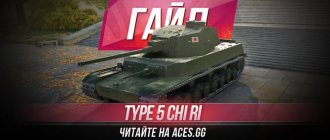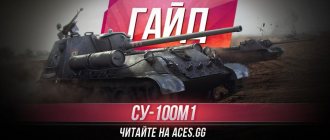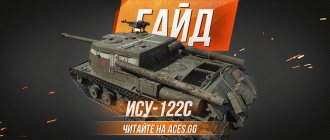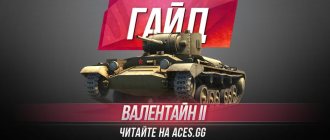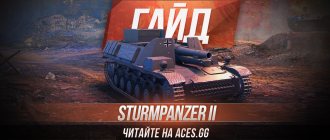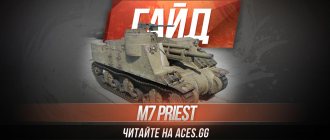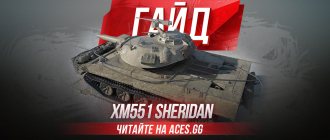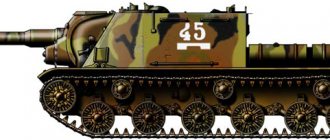Good day and welcome to aces.gg! Tankers, today we have on our agenda a strange, and in the opinion of most players, a rather mediocre British-made vehicle, we are talking about a level seven tank destroyer - this is the Challenger guide
.
At first glance at this device, you begin to suspect some kind of trick, the British model looks like a “specific cactus”, and upon closer examination of the Challenger performance characteristics
several unpleasant nuances are noticed at once, but first things first.
Modules
Engines
Suspensions
Radios
Compatible Equipment
Compatible Consumables
Player Opinion
Pros and Cons
- Very fast speed and surprisingly good traverse (for a TD), can let it play a flanking role or fall back when in danger
- Great gun depression of 10 degrees all around the tank
- Good gun handling and accuracy lets even less experienced players nail shots frequently
- Very fast RoF compensates for the horrible alpha damage
- Has a turret and pivots unlike most TDs of same tier
- Large size and thin armor makes you easy pickings for enemy tanks, especially arty
- 2nd turret has a mere 40mm of frontal armor (200mm on the back, which is rarely useful)
- 32pdr limits turret traverse to 60 degrees on either direction
- Awful stock grind if coming straight from the Firefly as none of the guns are available
Performance
WHen it was introduced, this tank suffered from a poor synergy between the vehicle and the gun. The 17 pounder's low alpha damage required that you hit targets repeatedly in order to do significant damage, but the vehicle lacks the armor to stand up to return fire and it's large silhouette and poor camouflage values make this tank difficult to conceal (even with camo- oriented setup, most enemies will spot you from about 350m). The resulting combination was reminiscent of an M18 Hellcat that lacks the 90 mm gun. This is playable at Tier 6, but for a Tier 7 vehicle it poses significant difficulties. Since Patch 9.20.1 the Callenger has been buffed with the 32 pounder gun, which allows it to operate as a sniper, combining reasonable alpha damage with good accuracy.
The primary role of this tank is long-range sniping. Its decent mobility allows it to take advantageous positions early and quickly change positions, should such need arise. Avoid close-range fighting — poor armor, slow traverse and low accuracy while moving make you an easy prey for most light and medium tanks you encounter. After the Buff in update 9.15, it is a reasonably effective flanking tank, especially with the top gun and turret and on maps such as Malinovka, where the good maneuverability will allow you to harass enemy tanks from behind rather effectively. An important aspect to this way of playing the Challenger is planning. The turret traverse is very slow, so you need to turn it in the right direction well in advance, the follow whatever route past the target that you have chosen. Keep in mind that the Challenger lacks a gun mantlet, so working a ridge-line, or going hull down is not a viable option. When low tier, the Challenger can perform well as a passive scout. Just make sure not to fire any shots as it will cost you most of your camouflage
An interesting thing to note is that the stock turret of the Challenger is very similar to the turret on the TOG II*. This is not coincidental; during development, the TOG II* was fitted with a variety of turrets, the final configuration seen today in the Bovington Tank Museum and in the game used the Challenger's turret.
Early Research
The first thing that you definitely want to research is the gun, the tank is useless without the second gun and so it is a must.
Next, research the second turret, as it will give you a huge RoF boost and is actually lighter than the first.
Once you have the second turret, research the top gun.
After this, research everything else in any order, it doesn't really matter.
Note that if you've fully researched the Achilles, you'll have all modules available immediately with the exception of the turret and tracks. The 2nd turret is lighter than the stock turret, so the tracks can be researched last, if at all.
Suggested Equipment
Documented Tank and Crew Builds
Since stealth and manoeuvrability are your only defense, you will need to train camouflage on all crew members. Once the first skill is at 100 percent, immediately change the commander to sixth-sense. Skills like situational awareness and recon to increase the view range are also useful. However, keep in mind that this is not a tank you are likely to keep in your garage once you have unlocked the Charioteer, so additional crew-training should focus on the needs of future vehicles.
External Reviews and Opinions
Gallery
Historical Information
The Tank, Cruiser, Challenger (A30) was a British tank of World War II.
It mounted the QF 17-pounder anti-tank gun on a chassis derived from the Cromwell tank to add heavier anti-tank firepower to the cruiser tank units. The design compromises made in fitting the large gun onto the Cromwell chassis resulted in a tank with a powerful weapon, but with less armour. The extemporized Sherman Firefly conversion of the US-supplied Sherman was easier to produce and, combined with delays in production, meant that only 200 Challengers were built. However, it was able to keep up with the fast Cromwell tank and was used alongside them.
The driving force in the development of Challenger was Roy Robotham. Robotham had been a Rolls-Royce executive in the car division who, with no work to do, had led a team to develop a tank powerplant from the Rolls-Royce Merlin aircraft engine. The Rolls-Royce Meteor gave the British a powerful, reliable engine, which would power the A27M Cruiser Mk VIII Cromwell tank. Robotham's contributions gained him a place in the Ministry of Supply and on the Tank Board, despite his lack of experience in tank design.[5]
The General Staff brought forward specification A29 for a 45-ton 17-pounder-armed cruiser tank based on needs identified in the African desert campaign. The design weight of this vehicle was too heavy however, and prior to manufacture the specification was passed over in favor of the alternate specification, A30 at 10 tons lighter.[6]
In 1942, an order for an A30 based tank was placed with Birmingham Railway Carriage and Wagon Company (BRC&W) expecting it to be based on the Cromwell components also being manufactured by BRC&W. Turret and gun mounting was in the hands of Stothert & Pitt. Birmingham Carriage had to modify the Cromwell hull to take a bigger turret.
The design received additional emphasis when it was found in May 1943 that the Cromwell was not going to be able to fit its intended armament. Vickers had been developing a 50-caliber-long 75mm “High Velocity” tank gun. It was realized late in the design process that the Cromwell's turret ring was too small to mount this 75 mm (3.0 in) gun.[7] the Challenger would be the only British cruiser tank to mount a weapon that could weigh heavier German armor until the arrival of the A34 Comet.
British tank production was a limited resource however, and insufficient numbers could be made. In the lead-up to D-Day, Sherman tanks were upgraded with the 17-pounder creating the interim Sherman Firefly. Conversions of Sherman tanks to Fireflys was simpler than production of Challenger, and the A30 order was canceled after about 200 had been built allowing BRC&W to focus on production of the Cromwell.
The tank was rendered obsolete when the Vickers HV 75 mm gun was developed to become the 77mm HV (actually 76.2 mm caliber) to arm the Comet tank. The 77mm HV used the same projectiles as the 17-pounder although with a reduced propellent charge compared to the 17-pdr. The 17-pdr was briefly used on earlier marks of Cromwell's successor -the Centurion tank.
The tank destroyer was created in 1942 on the basis of the extended chassis of the Cromwell tank. One of its undoubted advantages was the most powerful British 17-pounder tank gun at that time, which allowed the A30 to hit any enemy tank at a distance of up to 1000 meters. Among the disadvantages of tank destroyers are the overloaded chassis and impressive dimensions. During the serial production period, only about 200 vehicles were produced.
Shuttle disaster
The last launch of the shuttle was scheduled for the morning of January 28, 1986, then the launch was postponed to two o'clock in the afternoon due to the fact that minor breakdowns were found, which were repaired by engineers. The television broadcast live from Cape Canaveral. To fill the pause caused by the repair of the ship, the presenter talked about the history of the Space Shuttle program, predicting a great future for the new miracle of rocket technology. The Challenger launch was watched by millions of spectators around the world. At the 73rd second of flight, at an altitude of 14 km, the left solid fuel accelerator separated from one of the two mounts. After spinning around the second one, the accelerator pierced the main fuel tank. Due to the violation of the symmetry of thrust and air resistance, the ship deviated from its axis and was destroyed by aerodynamic forces. As it turned out later, some astronauts were still alive, since the bow part where they were located was simply torn away from the rest of the ship, and at least three of them began to receive individual oxygen supply to their helmets, provided in case of an accident, but a fall from 20 km altitude and colossal force (overload about 200 G), the impact on the water did their job, all the astronauts on board died. At first, numerous eyewitnesses did not understand what was happening.
The entire crew died - seven people, including the first non-professional astronaut - former teacher Christa McAuliffe, who won a national competition for the right to fly into space, organized on the initiative of US President Ronald Reagan. She became a national heroine of America.
The cause of the tragedy is said to be a malfunction of the ring seal of the solid propellant accelerator, which caused a leak of hot gases that destroyed the mount, as well as the fact that the launch was carried out at a temperature of 2 degrees below zero Celsius, while the recommended air temperature for takeoffs is 11 degrees Celsius or more. . In connection with this disaster, the United States suffered heavy losses - about 8 billion dollars, including the cost of the shuttle itself, which is estimated at 3 billion. The death of the Challenger was the largest disaster in the history of manned flights at that time, a strong blow to the reputation of the United States and the program Space Shuttle.
Challenger in the game
Research and leveling
The Challenger tank destroyer is researched on Achilles for 59,100.
Combat effectiveness
Challenger (Tier VII tank destroyer) - created on the basis of the Cromwell medium tank, which determines some similarity with the gameplay of medium tanks.
The machine has a set of balanced characteristics, it is generally comfortable to play on, so it can be used depending on the individual preferences of the player. While not having high one-time damage, the vehicle nevertheless has very good damage per minute and gun parameters that allow it to comfortably inflict this damage. The gameplay is very similar to the previous tank: constantly moving around the map together with allies, concentrating damage, distracting the enemy and intelligently implementing the strengths of the vehicle. Vertical aiming angles (gun declination) make it possible to effectively use terrain folds when firing.
- 360 degree rotating turret with stock and pre-top gun;
- excellent dynamics and maneuverability;
- accurate, fast-firing and comfortable weapon;
- good UVN.
- weak armor;
- low turret rotation speed;
- with the top gun, the turret rotates only 120 degrees (60 degrees in each direction);
- low one-time damage and mediocre penetration of guns;
- large tank sizes;
- relatively small ammunition load;
- poor camouflage;
- small review.
Crew
- Combat Brotherhood
will increase the characteristics of the tank. - Repair
will speed up the repair of damaged modules. - Camouflage
will increase the stealth of the vehicle; in addition, you can apply camouflage. - The combination of Eagle Eye
+
Radio Interception
will increase your visibility by 5%. - The combination of Smooth turret rotation
+
Smooth movement
will allow you to waste less time on alignment when moving and turning the turret. - The sixth sense
will help determine whether a tank is detected or not. - The sniper
will increase the destructive power of the gun. - The off-road king
will increase mobility on soft soils. - Desperate
will increase DPM in heated battles.
Equipment, equipment and ammunition
- Rammer
- will reduce the reload time of the gun. - Stereo tube
- to shine light on enemies before they notice you. - Improved ventilation
will improve all the main characteristics of the tank.
Standard equipment - fire extinguisher
,
repair kit
and
first aid kit
.
The bulk of the ammunition consists of armor-piercing shells; it makes sense to carry several special sub-caliber shells for encounters with armored opponents. High-explosive fragmentation ones are worth loading to knock down a grapple or finish off opponents with a small margin of safety.
Good day and welcome to aces.gg! Tankers, today we have on our agenda a strange, and in the opinion of most players, a rather mediocre British-made vehicle, we are talking about a level seven tank destroyer - this is the Challenger guide.
At first glance at this device, you begin to suspect some kind of catch, the British model looks like a “specific cactus”, and upon closer examination of the Challenger performance characteristics, several unpleasant nuances are immediately noticed, but first things first.
Specifications
Armor: Hull – 88/50/38 Turret – 101/40/40 stock – 50/40/200 top Strength 840..900 Chassis traverse speed – 26..30 degrees/sec. The turret rotation speed is 14..16 degrees/sec. Vertical guidance angles +20..-10° Maximum speed +52..-20 km/h Engine power – 600..650hp Weight – 28.29 tons. Specific power – 22.97 hp/t. Viewing range – 360..370 m Communication range – 450..700m Crew: 5 people
TTX Challenger
To begin with, it is worth saying that our self-propelled gun has far from the smallest, but quite modest margin of safety, as well as a good basic visibility with a range of 370 meters.
From the point of view of survivability, this device is also very weak, to begin with, the Challenger’s armor characteristics are very poor. The hull pliably absorbs damage from all enemies encountered in battle, the tower is even softer, so there is nothing to say here. No matter how you tighten the body, it will not help, so under no circumstances rely on the armor.
I would like to say that the Challenger WoT tank destroyer compensates for the lack of armor with phenomenal accuracy, but that would be a lie. This car has a tall silhouette, so camouflage is far from the best.
However, the British Challenger tank is designed on the basis of the sixth level Cromwell ST, thanks to which our self-propelled gun has excellent mobility. We can boast of a good maximum speed, excellent dynamics, and even the maneuverability here is very decent.
Review
Challenger is the latest British tank destroyer to be fitted with a 17-pounder gun at the top. And it is on Challenger that its penetration of 171 mm is often no longer enough even against level 7 vehicles. And if you fire only with basic shells (i.e., without gold at all), then you are guaranteed frequent failure to penetrate.
On the other hand, sub-caliber shells with an inexplicable penetration of 239 mm solve almost all problems. Most of all, oddly enough, Challenger resembles the E-25 in its play style - just as nimble, fast-firing and glass, and now also with a turret. But no one introduced a preferential level of fighting for him.
gun
Now let's turn our attention to the armament of this British woman, but don't get your hopes up too much; the gun can hardly be called powerful or truly comfortable.
Let's start with the fact that the Challenger gun has a very small alpha strike, for some this moment will be critical, but you shouldn't despair too much, the excellent rate of fire allows you to deal about 2300 damage per minute, which is very good.
The real downside is that the gun has weak armor-piercing qualities. Challenger World of Tanks is capable of reaching the top of the list very effectively, there will be practically no problems, but level 8 and 9 vehicles get through much worse, so it’s better to carry 20%-30% of gold ammo with you.
As for the accuracy and comfort of dealing damage, there are no complaints here. The Challenger tank has a very compact dispersion circle, excellent aiming speed, but the stabilization is weak, but we are talking about a self-propelled gun. In addition, our barrel lowers by 10 degrees and rises by 20, everything is fine.
Introduction
Estimates of the likelihood of a catastrophic system failure resulting in the loss of a ship and loss of life range strangely from about 1/100 (engineers' estimate) to 1/100,000 (management's estimate).
What are the causes and consequences of this mismatch? A probability of 1/100,000 means that every day for 300 years a shuttle could be launched and only one of them would die, so a better question would be, “What is the reason for management’s fantastic faith in the reliability of the system?” We have also found that the certification criteria used for flight readiness testing are gradually becoming less stringent. The fact that a certain fault has not caused a crash in the past is often taken as an argument for the “safety” of flying with that fault, and obvious problems appear again and again, often without any attempt to correct them or delay the flight.
Several sources of information were used:
- Criteria for flight certification, including history of changes in testing methodology. Flight readiness check records before each launch document all safety-related discussions and decisions.
- Information about the history of solid rocket launches was obtained from direct testimony and reports from site safety officer Louis J. Ullian. He subsequently (as Chairman of the Launch Abort Safety Panel, LASP) investigated the likelihood of accidents resulting in radioactive contamination during launches of plutonium-powered RTGs for future missions, plus a similar NASA study.
- Interviews with Marshall executives and engineers, and informal interviews with Rocketdyne engineers for the book The History of the Space Shuttle Main Engines.
- An informal conversation with an independent engineer from the California Institute of Technology who advised NASA on propulsion.
- A conversation with NASA JPL engineers about the reliability of avionics (computers, sensors and actuators).
- Report "Review of Certification Practices Potentially Applicable to Manned Reusable Rocket Engines" prepared at the Jet Propulsion Laboratory by N. Moore et al. in February 1986 for NASA Headquarters. It examines the methods used by the FAA and the military to certify gas turbine and rocket engines. Informal comments were also received from the authors of this report.
Advantages and disadvantages
Based on all of the above, it turns out that the car in our hands seems to be quite good, but it’s impossible to call it really strong. A sort of average game that many will pass and forget, however, it is still worth knowing what Challenger World of Tanks has strengths and weaknesses. Pros: • Good overview; • Excellent mobility; • The presence of a rotating tower; • Very worthy CSA; • Good accuracy; • Comfortable vertical aiming angles. Cons: • Cardboard armor; • High silhouette; • The tower rotates very slowly; • Weak alpha strike; • Mediocre penetration by armor-piercing projectiles.
Negative aspects of challenges
Sometimes the challenges have quite dangerous and difficult tasks. In search of thrills, fame and love, some participants can go far. At the same time, they completely forget about life principles and morality and see their most important goal as gaining respect/authority and proving their “fearlessness.” This can not only be dangerous for a person’s spiritual beauty, but also harmful to health.
Interesting challenge videos tend to be shared quickly and widely. The video can quickly become popular and be remembered by Internet users. If there is something reckless or shameful about him, perhaps in the future you will be very embarrassed because of him, and information on the Internet will not allow you to forget about it.
Equipment for Challenger
In order for battles on this device to be more comfortable, you have a chance to cause as much damage as possible and benefit your team, it is important to choose the right additional modules, improving your strengths. For the Challenger, selecting equipment is not too difficult: 1. – the choice is necessary at all times, since it will significantly increase your already good DPM. 2. – we already have a decent review on our side, and this module will make it even more enjoyable, especially in combination with some perks. 3. – will give the self-propelled gun all the necessary bonuses, that is, rate of fire, aiming speed and will improve the visibility a little more.
As such, there is no alternative to the three points stated above, however, for those who prefer a passive style of play, the second and third modules can be changed to and respectively. Thanks to such preferences, you can easily maximize your viewing range and improve your rather weak camouflage.
Scientific goals
The Royal Society stated the scientific objectives of the voyage were:
- Explore the physical conditions of the deep sea in large ocean basins—as far as the Great Southern Ice Barrier region—with respect to depth, temperature, circulation, specific gravity, and light penetration.
- To determine the chemical composition of sea water at various depths from the surface to the bottom, organic substances in solution and particles in suspension.
- Establish the physicochemical nature of deep-sea sediments and their sources.
- Explore the distribution of organic life at different depths and on the bottom of the sea.
Inspection of the caught specimen
At each of the 360 stations, the team measured bottom depth, temperature at different depths, observed weather and ocean surface conditions, and collected samples of the seabed, water and biota. Challenger crew
To carry out observations, I used methods developed in previous small expeditions.
To measure depth, they lowered a fishing line with a weight attached to it until it reached the seabed. The line was marked at 25 fathom (150 ft; 46 m) intervals with flags indicating depth. Because of this, depth measurements from Challenger
were, at best, accurate to the nearest boundary by 25 fathoms (150 ft; 46 m). A small container was often attached to the sinker, allowing sediment samples to be collected.
The crew used a variety of dredgers and trawls to collect biological samples. The dredgers consisted of metal nets attached to a wooden plank and dragged along the seabed. The mop heads, attached to a wooden board, will bounce around the sea floor and release organisms from the ocean floor that are then caught in the nets. Trawls were large metal nets towed behind a vessel to collect organisms at varying depths of water. After retrieving the dredge or trawl, the Challenger
sorts, washes and stores specimens for examination upon return. Specimens are often preserved in either brine or alcohol.
The main thermometer used throughout the Challenger
there was a Miller–Casella thermometer, which contained two markers in a curved mercury tube to record the maximum and minimum temperatures through which the instrument passed.
Some of these thermometers can be lowered to different depths for recording. However, this design assumed that water closer to the surface of the ocean was always warmer than the water below. During the voyage, the Challenger
's crew tested a reversible thermometer that could measure temperature at specified depths. Subsequently, this type of thermometer was widely used until the second half of the 20th century.
Sir Thomson believed, like many adherents of the recent theory of evolution, that the deep sea would be home to "living fossils" long extinct in the shallows, examples of "missing links". They believed that conditions of constant low temperature, darkness, and the absence of currents, waves, or seismic events provided such a stable environment that evolution would slow or stop completely. Louis Agassiz believed that in the depths “we should expect to find representatives of earlier geological periods.” Thomas Huxley stated that he expected to see "zoological antiquities which, in the calm and little-changed depths of the ocean, have escaped the causes of destruction operating in the shallows, and represent the predominant population of the last century." However, nothing of the kind happened; although several organisms previously thought extinct were discovered and cataloged among the many new discoveries, the harvest was typical of what would be found when exploring any equivalent extent of new territory. Additionally, in the process of preserving the specimens in alcohol, chemist John Young Buchanan and Sir Thomson realized that he had inadvertently refuted Huxley's previous report of Bathybius haeckelii
, a cell-free protoplasm covering the seafloor that was thought to be the link between
nonliving
matter and living cells. The net effect was a setback for evolutionists.
Tactics for playing Challenger
Due to its large silhouette, lack of armor and powerful alpha strike, our self-propelled gun can rightfully be considered the so-called “red line vehicle”.
What does it mean? It's simple - for Challenger, combat tactics consist of maximizing distance from enemy forces and shooting damage from long distances. As you know, we have a fairly accurate weapon and a high rate of fire for this.
However, it is worth considering that the Challenger World of Tanks tank destroyer does not have the best penetration parameters. In view of this feature, at the top of the list you will be able to fight more than comfortably; you can penetrate the enemy even at a distance of 300-400 meters.
Otherwise, despite such rather passive tactics, active actions are not alien to our Briton. Thanks to its excellent mobility, the Challenger tank can take advantageous positions among the first, quickly change flanks, and, if necessary, even provide illumination to its allies. Remember only about weak armor and a small margin of safety.
Hello everyone, we are glad to see you again on aces.gg! Today in the guide we will talk about another premium tank, but with an interesting feature. So, here is a guide to the British premium heavy tank Tier 8 Charlemagne!
This car is noteworthy for 2 reasons. First of all, this is not an alpha characteristic of British TTs, and secondly, this is another “defender killer”!
Both externally and in terms of overall performance characteristics and gameplay (but with its own characteristics), the tank will compete with the Object 252u “Defender” and 50TP prototyp.
Detailed performance characteristics of Charlemagne
The tank was slightly nerfed in recent tests. First of all, his maximum speed was reduced to 35 km/h, and the dynamics and movement dispersion were also nerfed, which only brought us closer in gameplay to the defender and the Pole.
Essentially, we have the body and mobility from the Pole and the gun from the defender. But + comfortable UVN. All other performance characteristics are quite familiar to many World of Tanks players. This has good armor penetration, high one-time damage and good armor for the front of the hull and turret.
Historical reference
Having experimented a lot with the overseas Shermans, the British designers decided to build themselves a medium tank with a more or less acceptable weapon, in the form of a 17-pounder gun. Their choice fell on the brand new Cromwell, which, although it was quite a good medium tank, was rather late, and was in no way capable of fighting against the Panthers and Tigers.
The result of this research was the Challenger cruiser tank. After rummaging around in the warehouse, the designers discovered an unregistered turret from the TOG-2* and happily stuck a 17-pounder into it, and then bolted it all onto the Cromwell chassis. True, the chassis, due to the additional load, had to be lengthened (apparently the TOG-2 stood before my eyes as if alive).
After driving the new tank for some time, the British decided to repurpose it into a tank destroyer and changed its turret (leaving the original gun). The new turret turned out to be less armored, more spacious and with an open top. All this disgrace was pathetically called the Avenger and sent to the front. However, while they were driving the front ended, but that’s another story...
Due to the lack of armored vehicle production capacity in the UK, local applicants for the LEP (Life Extension Project) to extend the service life of the British Challenger 2 main battle tank are forced to rely on foreign experience when applying for this program.
The LEP project is currently gaining momentum, with the UK Ministry of Defense receiving applications from five teams as part of the project's performance assessment phase.
London reduced the number of applicants to two and, although a decision was expected on September 1, 2016, it has now been postponed until later that year.
BAE Systems and GDLS were the first to submit applications, while CMI Defense and Ricardo UK announced their interest at the Eurosatory exhibition. Lockheed Martin UK and Elbit Systems publicly announced this on 10 August, while Rheinmetall, along with RUAG Defense, announced their collaboration with Supacat, Thales UK and BMT just before the application deadline on 11 August.
The two bidders selected for the assessment phase will each receive contracts worth £19 million.
This phase will last two years, until the end of 2022, when the winning team will receive a contract for preliminary testing, production and service. The British Ministry of Defense plans to modernize 227 Challenger 2 tanks
. The only company with any experience with the Challenger 2 tank is Babcock DSG, which received a contract from the Ministry of Defense to maintain and supply tanks located at the military base in Bovington; at the same time, the company will remain in the game no matter the outcome of the competition.
The invitation to contract negotiations at the evaluation stage stipulates that applicant companies must submit options for the supply of new equipment that they wish to supply “in conjunction” with the main service provider and these applicants “will be required to demonstrate a desire and ability to work with Babcock DSG.”
The BAE System company at one time manufactured Challenger 2 tanks, but lost its competence in this platform and in general in modernizing main battle tanks. It is not a fact that the company is an automatic winner in this competition; it needs joint work with the American GDLS, which has experience in manufacturing and modernizing the M1 Abrams MBT.
BAE has a reference collection of machines it once made at its Telford plant; they are now being used to develop new variant upgrades and training. At the same time, they say that work on the modernization of the Challenger 2, designated the “Mark 2” standard, will be carried out at the GDUK plant in Wales.
The situation regarding the application from Lockheed Martin UK and Elbit Systems is similar.
LMUK had no experience in MBT modernization and cooperation with Elbit. But much of the work on the LEP project is related to the turret, and LMUK has an advantage here because it owns the turret manufacturing plant in Amphill, where work is underway to modernize the Warrior infantry fighting vehicle and implement the new Ajax program. The company could undertake work on the Challenger 2 LEP project here or in Bovington. Turrets on the assembly line at the Ampthill plant
According to Richard Muir, business development director at LMUK, the evaluation phase of the LEP project is "very well synchronized with the WCSP (Warrior Capability Extension Programme) and Ajax projects." Since all these programs have already been sufficiently developed, the “risk” of transferring resources from them to research and development under the program for the Challenger 2 tank is minimal.”
The Ajax and Warrior programs will end in 2022-2023, so the Amphill plant has some potential in the future and is looking forward to the next big program.
Of some concern is Oman, which, with its 38 Challenger 2 tanks, has observer status in the LEP project. Will this country be happy with the team of participants, which includes the Israeli Elbit, as well as the modernization of its tanks, given the transfer of technology from Israel?
However, Muir insists that Lockheed Martin UK and Elbit Systems UK remain British firms, despite the fact that their parent companies are American and Israeli, respectively.
LMUK's application also draws on Elbit's experience in modernizing the M60, T-72 and Merkava tanks (from top to bottom)
Will life extension turn into modernization?
Research to improve firepower will be conducted as part of the evaluation phase and applicant teams will be able to propose new technologies. But at the same time, Muir warned that “all this must be economically justified and meet the customer’s requirements.”
LMUK is considering the inclusion of anti-tank guided weapons and target designator to achieve an integrated fire control network. Also in 2022, a decision is expected from the British Ministry of Defense on an optical-electronic countermeasures system, which may also be included in the modernization program.
However, the Ministry of Defense's plans to purchase an intermediate thermal imaging unit for the Challenger 2 tank were not destined to come true.
According to industry sources, the decision on its purchase will be made within the framework of the LEP project. Replacing the gun could significantly improve firepower, but it all comes down to funding.
Although there was no requirement to replace the 120mm L30 rifled gun, the industry was quite serious about whether it could offer a new gun within the £642 million budget. ?
Rheinmetall supplied the 120 mm L/55 smoothbore gun as part of the technology demonstration program as part of the Challenger 2 tank modernization proposal carried out in 2003-2006, but there were no funds for this then. It is clear that the installation of a new gun entails new optics, a fire control system and rearrangement of ammunition storage areas and, as a result, an increase in cost.
However, it makes sense for Rheinmetall to make another offer. If the British Army were to reduce the number of its Challenger 2 regiments from three to two, this would mean that the LEP project would include fewer tanks, which could free up some funds (though still not enough to replace the gun).
The company has extensive experience in modernizing Leopard 2 tanks and therefore understands all the complexities of such a program better than other competitors.
Rheinmetall definitely needs this work, since its German partner and competitor KMW is busy modernizing the German Leopard 2 tanks and Rheinmetall has no choice but to fight for export orders.
Options for increasing firepower are presented.
Can industry make the British Ministry of Defense an offer it can't refuse? In addition to firepower, there are issues of mobility and protection. The Challenger task force's prospectus makes no mention of power or armor replacement, only the "possibility of future capability enhancements," implying greater expense, although the Department of Defense is considering installing an active protection system on all armored vehicles in a separate project.
Materials used: www.shephardmedia.com www.baesystems.com www.wikipedia.org ru.wikipedia.org
Of the modules, I advise you to install the above-mentioned optics, of course a rammer and ventilation, which will increase all the characteristics of the machine, which it clearly lacked. Among the perks, in addition to repair, a light bulb and stabilization are required.
Let's go to battle
Unfortunately, it turns out we have disgusting stabilization, but ok, at least the mixing is fast.
We go together to ST and occupy a convenient bush. An enemy appears - we fire a couple of shots. The lamp lights up! 3... 2... 1... One-shot from Geschutzwagen Panther. Okay, now let's get serious. Poor camouflage and a small alpha strike do not allow us to play a full-fledged PT, so we try to find a closed position at medium and long distance with the enemy. An ideal example is the central hill on Redshire or the bushes at both ends of the city on Westfield. In any case, we try to go to the place where tanks with good air defense systems rule. We find some fat-assed ally and hide on him. As soon as the enemy in front of you goes into CD, we fly out, give 2-3 buns and roll back.
Level 8-9 fight. In such battles, Challenger is simply a tasty piece of damage for the tops. Here you should behave as carefully as possible, and under no circumstances should you meet drum tanks head-on. In the heat of battle, we find ourselves a delicious French bun or a square German nut and start snacking until it falls apart. Next, you need to wait a few seconds so that the enemies forget about us. Enemy ART-SAUs are already starting to lick their lips and imagine how they will send a shell with full damage directly to our loose MTO. Having waited, we will again begin to look for a victim. A good tactic is to keep armored tanks on tracks while the allies dismantle them.
Well, if you have silver, then the situation changes. With our gold we penetrate most of the enemies even with auto-aim. We stand in a distant bush and show our British might to our adversaries.
The fight is at the top. Here the machine shows itself in all its glory. - the main firepower of the team. Any tank can be disassembled head-on, but it won’t be possible to break into an attack again, the hull and turret are too flimsy. Thanks to the speed, we fly to a convenient shooting point, for example, the central city on the Fisherman's Bay map. There will be blind IS-2s and KV-85s driving there, which can be burned with impunity by knocking out the tanks with 2-3 hits. When shooting blind, the main thing is not to overdo it; 55 shells of this caliber will fly away very quickly. Ideal locations are the central mountain on the mines or the mountain on the robin. The car usually gets there first, then everything that dared to go under our trunk is simply disassembled.
conclusions
A common anadromous cactus with an exceptionally ugly appearance. Poor camouflage, poor visibility, low maneuverability, relative to dynamics, not a PT weapon at all. However, sometimes it will bring joy to its owner. DPM and accuracy make the difference after all. It’s definitely not worth farming silver with it. The 15 sub-caliber shells that I took with me were lost almost every battle, and they cost quite a lot - 3200 apiece. IMHO he would look good as a lvl 7 premium with a reduced level of battles. Do I need to complete it for free experience? My opinion is no. If you like vehicles with fast-firing guns, if you want a challenge rather than an easy bend, this is the cruiser tank for you. Thank you for your attention.
21-12-2016, 02:05
Good day and welcome to the site! Tankers, today we have on our agenda a strange, and in the opinion of most players, a rather mediocre British-made vehicle, we are talking about a level seven tank destroyer - this is the Challenger guide
.
At first glance at this device, you begin to suspect some kind of trick, the British model looks like a “specific cactus”, and upon closer examination of the Challenger performance characteristics
several unpleasant nuances are noticed at once, but first things first.
Equipment for Charlemagne
As is usually the case, when equipping a tank with modules, you need to try to enhance its strengths and brighten up its shortcomings. In the case of Caernarvon, equipment is selected as follows: 1. – a mandatory module, since only with it can you achieve acceptable damage per minute. 2. – improvement of the already good stabilization of the gun, hence higher accuracy and the ability to shoot immediately. 3. – this option will improve our review, which is already good.
There is a very good alternative to the last point - this is, because it gives a good boost to many characteristics, so some may like it even more, but it is better to install it when you upgrade the crew. Regarding the installation of new additional equipment. Here it is worth paying attention to hardening or an improved layout. These 2 modules can increase the survivability of your tank.
What does "challenge" mean?
Challenge comes from the English challenge, which in turn translates as “problem, difficult task, challenge.” In Russian, it has received the concept of challenge and is most often used and understood in content as “throw/accept a challenge.” If you look for popular slang analogues of purely domestic origin, then this is “to make it weak.” In English, challenge is rarely used in this sense.
Using the word "challenge" in English:
We
are challenged to produce a precedent / We were faced with the need to create a precedent
I
see the job as a challenge / For me, this job is a challenge, a test
He took up my challenge
/
He accepted my challenge
In Russian, a challenge is most often a task, in most cases difficult, that must be completed so as not to “disgrace yourself,” look cool, brave, or simply test your strength, gain emotions, assert yourself, etc. Many consider this a kind of reality game.
The challenge basically has two meanings. In the first case, it is closer to the direct meaning of the word challenge. In the second, it is an interesting and sometimes dangerous game, a kind of quest.
Classic challenges literally refer to achieving goals. For example such as:
- Climb the volcano
- Master the guitar
- Cycle 100 km
- Rafting down the river
The following examples can be given from “simpler” challenges:
- Make mehendi
- Master the balance board
- Build a sand castle
- Learn to cross stitch
See other examples of challenges
Challenge for personality
The older generation regards challenges as a useless exercise and another empty exercise, but in reality this is not the case. They will be very useful if you find the right use for them. Challenges are any challenges, including those that we challenge ourselves. With their help, people can fight their shortcomings, weaknesses, and fears.
So, what does a personal life challenge mean? This is when a person challenges himself and promises to achieve something in a certain period of time. And this is actually a very convenient and effective way to get rid of shortcomings, weaknesses and many things that don’t suit you in life. For example, you can promise yourself to earn a certain amount in a couple of weeks (an order of magnitude higher than usual) or to lose all excess weight in 3 months. And the fact that it was not “weak” for you to achieve a positive result will be your personal achievement.
What explains the effectiveness of a challenge in achieving success in any goal:
- There is a clear goal. A person knows exactly what he must achieve and when.
- There is a provocation. A person wants to prove to himself that he can and will achieve what he wants.
- There are certain deadlines. If in a normal case a person can allocate a period of his life to accomplish important goals, this is not the case.
We just have to try, and challenges will help us fight troubles in life. At the same time, you should remember that you need not only to challenge yourself, but also to do something, show diligence and work, so as not to lose in “disgrace.”
Drugs
To enable it to explore the depths, 15 of the Challenger's
were removed and the spars were reduced to create more space.
Laboratories, additional cabins and a special dredging area have been installed. Challenger
used mostly sails during the expedition; the steam engine was used only to power the dredger. It was loaded with sample jars filled with alcohol for storing samples, microscopes and chemical equipment, trawls and dredgers, thermometers, barometers, water sampling bottles, measuring leads, devices for collecting sediment from the seabed, and long ropes with which to hang equipment into the depths of the ocean.
Because of the novelty of the expedition, some of the equipment was invented or modified especially for the occasion. A total of 181 miles (291 km) of Italian hemp were supplied for probing.
Heritage
Results of the Challenger
continued to be published until 1895, nineteen years after the completion of her journey.
The report consisted of 50 volumes and ran to more than 29,500 pages. The samples brought back by Challenger
were submitted to the world's leading experts for study, significantly increasing the cost and time required to finalize the report. The report and specimens are currently held by the British Natural History Museum and the report is available online. Some samples, many of which were discovered first, are still being studied by scientists.
A large number of scientists worked to categorize the material brought back from the expedition, including paleontologist Gabriel Wharton Lee. George Albert Boulenger, herpetologist at the Natural History Museum, named after Challenger
lizard species
Saproscincus challengeri
.
Before sailing the Challenger
Oceanography was largely speculative.
Challenger
Expedition the first true oceanographic cruise, laid the foundation for the entire academic and research discipline.
" Challenger
" has been applied to phenomena as diverse as the Marine Science Society's
Challenger
, the oceanographic and marine geological research vessel
Glomar Challenger
, and the Space Shuttle
Challenger
.
